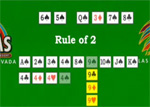Head up poker strategy
Heads up has become a really popular format in recent years, largely due to big events like the National Heads Up Championships where the winner walks away with a cool $500,000 in prize money. Playing heads up is about way more than these big events though. In fact, every single time you enter a tournament of any size, from a $5 buyin online SNG to the main event at the WSOP, you’ll have to go heads up at the end of you want to win. With that in mind, it’s a really good idea to work on your heads up game, and these 9 “top tips” you set you in the right direction.
- Position
Position is of course hugely important in poker, but in head up you have position 50% of the time. Take advantage, and use position when you have it to put pressure on your opponent. - Aggression
You need to be really aggressive in heads up. You’re only playing one opponent, so you know that more often than not they won’t be holding a great hand. If they don’t have a pocket pair, then they will only have a pair on the flop one out of every 3 hands, so use that knowledge to your advantage. You want to be raising and reraising most of the time not calling! - Pot Management
50% of the time you’ll be dealt the weakes hand. That means you will lose some hands no matter what, the key is to lose small pots and win big pots – careful control of the pot size is an essential skill to master. - Reading
Being able to put your opponent on a hand, or at least a range of hands gives you the advantage. Early on your should be studying their plays, figuring out what they like to do in different situations, so you can use that information when the time is right. - Adapting to your opponent
It’s no good reading your opponent if you don’t take advantage. If they are playing really tight then be aggressive and they’ll be folding too much. If they are playing relaly loose then call more often, and trap them when you have the best hand. - Knowing when to fold
Remember that you’ll have the weakest hand half the time. Being aggressive will only work when your opponent thinks they won’t win, but you need to know when you’re beat and get out of a hand before you bleed any more chips. - Bluffing
Bluffs work best against a small number of opponents, so work well in heads up. Time your bluffs well though. Wait for a flop that could be a great flush or straight draw for example, and if a “scare card” to complete the flush/straight comes on the turn or river, you might have a good chance of forcing your opponent to fold. - Varying your own play
Just as you’re trying to read your opponent, they are trying to put a read on you. So vary your own style, mix it up a bit, and make it as difficult as possible for your opponent to know what you’re holding. - Learn from your mistakes
You can sometimes learn more from losing than from winning, so think about your hands after the match. Study your plays, and learn to improve so you have a better chance of winning next time.






















